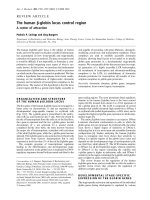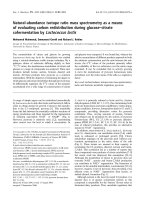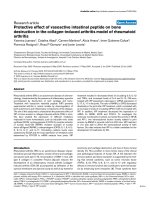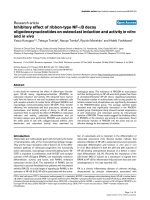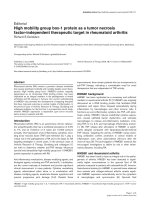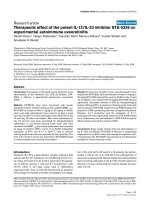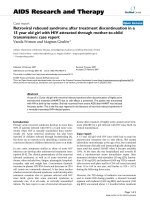Báo cáo y học: "Donnan effect on chloride ion distribution as a determinant of body fluid composition that allows action potentials to spread via fast sodium channels" pot
Bạn đang xem bản rút gọn của tài liệu. Xem và tải ngay bản đầy đủ của tài liệu tại đây (530.22 KB, 9 trang )
REVIEW Open Access
Donnan effect on chloride ion distribution as a
determinant of body fluid composition that
allows action potentials to spread via fast
sodium channels
Sven Kurbel
Correspondence:
Dept. of Physiology, Osijek Medical
Faculty, Osijek, Croatia
Abstract
Proteins in any solution with a pH value that differs from their isoelectric point exert
both an electric Donnan effect (DE) and colloid osmotic pressure. While the former
alters the distribution of ions, the latter forces water diffusion. In cells with highly Cl
-
-
permeable membranes, the resting potential is more dependent on the cytoplasmic
pH value, which alters the Donnan effect of cell proteins, than on the current action
of Na/K pumps. Any weak (positive or negative) electric disturbances of their resting
potential are quickly corrected by chloride shifts .
In many excitable cells, the spreading of action potentials is mediated through fast,
voltage-gated sodium channels. Tissue cells share similar concentrations of
cytoplasmic proteins and almost the same exposure to the interstitial fluid (IF)
chloride concentration. The consequence is that similar intra- and extra-cellular
chloride concentrations make these cells share the same Nernst value for Cl
-
.
Further extrapolation indicate s that cells with the same chloride Nernst value and
high chloride permeability should have similar resting membrane potentials, more
negative than -80 mV. Fast sodium channels require potassium levels >20 times
higher inside the cell than around it, while the concentration of Cl
-
ions needs to be
>20 times higher outside the cell.
When osmotic forces, electroneutrality and other ions are all taken into account, the
overall osmolarity needs to be near 280 to 300 mosm/L to reach the required resting
potential in excitable cells. High plasma protein concentrations keep the IF chloride
concentration stable, which is important in keep ing the resting membrane potential
similar in all chloride-permeable cells. Probable consequences of this concept for
neuron excitability, erythrocyte membrane permeability and several features of
circulation design are briefly discuss ed.
Background
This theoretical paper seeks to interpret similarities in pH, electrolyte and protein
compositions of body fluids among diverse animals as requirements imposed by their
excitable tissues, particularly neurons and muscle cells.
The logic that follows is based on a previously published argument that similar body
fluid osmolarity in various animals is dictated by the opposed Donnan effects of cell
proteins and of sodium ions sequestered in the extracellular fluid (ECF) [1]. The
Kurbel Theoretical Biology and Medical Modelling 2011, 8:16
/>© 2011 Kurbel; licensee BioMed Central Ltd. This is an Open Access article distributed under the terms of the Creative Commons
Attribution License (http://c reativecommons.org/licenses/by/2.0), which permits unrestricted use, distribution, and reproduction in
any medium, provided the original work is properly cited.
conclusion of the cited paper is that the ubiquitous ECF Na
+
concentration is deter-
mined by the average osmotic burden on animal tissue cells.
Basic assumptions behind the proposed model of the Donnan effect on body
fluid composition
The presence of proteins in any solution exerts two effects on the traffic of ions and water.
The first is the electric Donnan effect (DE), which alters the distribution of ions, and the
second is the colloid osmotic pressure, which forces water diffusion. Both phenomena are
measurable when a protein-rich fluid is in contact with a protein-free fluid through a
semipermeable membrane that does not allow protein molecules to diffuse [2].
Donnan effect (DE)
If protein-bound charges on one side of a semipermeable membrane cannot diffuse
through the membrane, the distribution of other ions to which the membrane is
permeable is alt ered [2]. These protein-bound charges are pH dependent, and in the
physiological pH range, proteins oveall carry a net negative charge. Thus, they attract
cations to enter the protein-rich compartment. Diffusible anions are expelled. The traf-
fic of anions and cations is equally governed by electric fields, concentration gradients
and ion-specific membrane permeabilities. Since the accumulation of ions within any
cell is followed by osmosis of water molecules, cell edema due to the Donnan effect of
cell proteins is prevented throug h the action of Na
+
/K
+
pumps. They expel 3 Na
+
and
import 2 K
+
in every cycle, so some water also leaves the cell. If the membrane perme-
ability for Na
+
ions is low, sodium ions are virtually sequestered in the extracellular
fluid (ECF), so although sodium ions are not proteins, their sequestered positive
charges alter the ion distribution across the cell membrane. This action is analogous to
the Donnan effect: ECF sodium ions pull more anions out of the cell. The only way for
the cell to reach osmotic equilibrium is to alter its volume until the concentration of
nondiffusible intracellular ions (mainly charges on intracellular proteins) is equal to the
concentration of ECF-restricted ions (mainly Na
+
) [3].
Owing to the balance of these two opposed Donnan effects, water diffusion is
reduced and the osmotic burden on tissue cells is diminished [1].
When the three main body fluid compartments - plasma, interstitial (IF) and cellular
fluid - are considered, difference s in chloride distribution across cell membranes and
capillary walls result not from chloride pumping, but from the Donnan effect of cyto-
plasmic and plasma proteins [4]. Both cellular and plasma proteins force negative
chloride ions to enter the protein-poor IF.
The resting potential of cell s that are highly Cl
-
-permeable is more dependen t on the
cytoplasmic pH value that alters the Donnan effect on chloride ions than on the momen-
tary pumping of sodium and potassium ions. The skeletal muscle resting potential is very
close to the chloride Nernst potential since the membrane is highly permeable to chloride
ions (10 times higher than to K
+
and 1000 times higher than to Na
+
[5]). A possible inter-
pretation is that in this setting, any weak (positive or negative) electric disturbances of the
resting potential are easily corrected by a chloride shift. If so, the described stabilization of
the resting potential is independent of sodium and potassium concentration gradients and
this independence of sodium pumping can make it act as an important safety feature
against involuntary, or spastic, skeletal muscle contraction.
Kurbel Theoretical Biology and Medical Modelling 2011, 8:16
/>Page 2 of 9
Colloid osmotic pressure
The presence of proteins in solution forces water to diffuse from the protein-free com-
partment and dilute the protein-containing fluid. This pressure is pH-independent and
is mainly related to the number of protein molecules acting as particles in solution.
Description of the proposed model of Don nan effect and body fluid
composition
Proteins in any solution with a pH value that differs from their isoelectric point always
exert both a DE and colloid osmotic pressure. Since the normal pH of our body fluids
ranges from 6.8 (cell fluid) to 7.35 (arterial blood), normal body fluid pH values are
much higher than the average amino acid i soelectric point. This makes all proteins in
our body fluids negatively charged [2]. So, even when our attention is focused on
plasma colloid pressure, or how DE alters ion concentrations in some fluid, we should
not neglect the presence of both DE and colloid osmotic pressure in all situations
involving proteins in body fluids.
Expected similar Cl
-
gradients in tissue cells
The model presented here is focused on excitable cells in which Cl
-
ions act as stabilizers
of their resting membrane potential because of high chloride perme ability [2,5]. Various
tissue cells probably share similar concentrations of cytoplasmic proteins. They are
under almost the same exposure to the IF chloride concentration. So, if the intracellular
pH is normal, similar Donnan effects on chloride ions can be expected in all Cl
-
-perme-
able cells. The consequence is that similar intra- and extra-cellular chloride concentra-
tions make these cells share the same Nernst value for Cl
-
. A further e xtrapolation is
that these cells, with the same chloride Nernst value and high chloride permeability,
should have similar resting membrane potentials, more negative than -80 mV.
If cells are surrounded with protein-containing fluid, the Donnan effect of the cyto-
plasmic proteins is opposed by the same effect of the extracellular proteins. Two
opposed Donnan effects result in higher intracellular chloride concentrations, as has
been reported in blood cells that normally float in protein-rich plasma [2]. In these
cells, sodium pumping is less important for maintaining t he cell volume, since the
osmotic burden is already reduced by the DE of the plasma proteins. This is a possible
interpretation of why the erythrocytes (RBCs) in some carnivores do not have active
sodium pumps [6]. A reduced intracellular protein concentration or slightly acidic
cytoplasm might allow these cells to maintain normal volume with reduced energy
expenditure.
Because of t he DE-mediated shift of Cl
-
ions described above (from protein-rich to
protein-poor fluid), the highest ch loride concentrations are reported in cerebrospinal
fluid (CSF), interstitial tissue fluid and lymph [2,7,8]. Thus, the Donnan effect of
plasma proteins enhances capillary filtration and hinders reabsorption of Cl
-
ions, so
interstitial chloride ions are forced to remain in the tissue to be returned to the blood
only via lymph drainage, helped by skeletal musc le work. In other words, high plasma
protein levels maintain the stability of the IF chloride concentration through their
Donnan effect, important in keeping the resting membrane potential similar in all
chloride-permeable cells.
Kurbel Theoretical Biology and Medical Modelling 2011, 8:16
/>Page 3 of 9
The model presented h ere is shown in Fiure 1, which is organized in two sections
with four paths. Each path is coded by a different letter and color. The pivotal fields
that link cell physiology with body systems have been intentionally left without color
code in the center of Figure 1.
Individual excitable cell homeostasis
The following discussion refers to the left hand side of Figure 1, paths A1 to A9:from
the spreading of action potentials to cellular control of pH and isotonicity in all body
fluid compartments and the plasma protein content.
Optimal function of neurons, skeletal and heart muscle cells is a prerequis ite for ani-
mal mobility and survival. Cellular reactions depend on prompt and well-defined
occurrence and spreading of action potentials. Action potential spreading in the afore-
mentioned cell types is mediated through fast, voltage-gated sodium channels. These
channels initiate rapid depolarization of the surrounding cell membrane, when the
local membrane potential is altered from the resting <-80 to -55 mV or less negative.
Several features are important for the function of fast sodium channels:
Membrane permeabilities to sodium, potassium and chloride ions define the resting
membrane potential, as defined by the Goldman equation (Table 1).
A sufficiently low resting potential that allows the sodium channels t o function
(Figure 1, A1) can be achieved only if the membranes are almost impermeable to
Na
+
(field A2), since any substantial sodium current would make the resting mem-
brane potential less negative than -80 mV, and this would leave sodium channels
inactive after repolarization.
INDIVIDUAL EXCITABLE CELL HOMEOSTASIS THE WHOLE BODY HOMEOSTASIS
Spreading
of action
potential
A1: Fast voltage gated sodium channels
require a stable -80 mV resting membrane
potential
B3: Lack of ECF
proteins in the
brain maintain
neuron activity
dependent on Cl
-
gradient
C3: Enhanced gas transport in RBCs due to
optimal chloride mobility
Respiratory
& CNS
actions
Membrane
p
ermeability
A2:
low
for
Na
+
A3:
hig
h
for
K
+
A4: High Cl
-
permeability
dampens small changes in
membrane potential, thus
preventing depolarization or
hyperpolarization
C2: Opposed Donnan effects of plasma and cell
proteins allow easy bidirectional chloride shifts
B2: CSF is reach
in Cl
-
ions &
almost protein
free
C1: RBCs´membrane is so permeable to sodium
that the membrane potential and Cl
-
Nernst
potential are similar
A5: Cl
-
ions are forced out of cells due to
Donnan effect of cell proteins
Forced ion
traffic
across the
resting cell
membrane
A6: Charges on excess proteins in interstitial
fluid, CSF & plasma force some Cl
-
back into
cells, change the Cl
-
gradients & thus alter the
resting membrane potential
B1: Donnan effect of plasma proteins return many Cl
-
ions from blood
to IF & CSF. IF Cl
-
ions return to blood by lymph
Role of
plasma
proteins
D1: Plasma colloid osmotic pressure opposes fluid filtration in
peripheral capillaries and in kidneys, also forces fluid reabsorption in
capillaries.
A7: Cell alkalosis
increases & acidosis
decreases number of
protein charges & shifts
Cl
-
between cell & ECF
A8: Na
+
pumped
out and K
+
pumped in, by
sodium pumps
D2: Pulmonary
circuit: colloid
pressure
prevents lung
edema & allows
high perfusion
rates
D3: Peripheral circuit:
capillary resistance &
hydrostatic pressure define
fluid traffic. Resistance
depends on capillary
diameter& length. RBC size
slightly exceeds the diameter
for better gas traffic
D4: Kidneys
through JGA
increase arterial
pressure until
sufficient
glomerular
filtration is
reached
Circulatory
actions
Homeostatic
control
loops
A9: Regulation of pH & isotonicity of cellular &
extracellular fluid (~7.35 & ~280mOsm/L), with
low IF proteins, help action potential spreading
Figure 1 Schemati c display that connects requirements for the fast sodium channel function (field
A1) with various aspects of cell physiology (left fields A2 to A9), neuron reactivity (middle top
fields B1 to B3), gas traffic in blood (right top fields C1 to C3) or circulation (bottom right fields D1
to D4). The pivotal role is reserved for the ECF protein concentrations (central white fields A6, B1, C1, D1)
as causes of a local Donnan effect and colloid osmotic pressure. Low IF proteins allow stable resting
potentials more negative than -80 mV to be generated. Plasma proteins are optimized to help the chloride
shift in RBCs, which is important for gas transport and in pulmonary circulation, peripheral tissue fluid
traffic and renal control of arterial pressure.
Kurbel Theoretical Biology and Medical Modelling 2011, 8:16
/>Page 4 of 9
Combined high permeability for potassium (field A3) and chloride (field A4) moves
the resting membrane potential to the require d range, more negative than -80 mV,
if the concentration gradients for these two ions are sufficient:
-K
+
concentrations: low outside and high inside the cell, maintained by Na/K
pump function;
-Cl
-
concentrations: high outside and low inside the cell, due to the Donnan
effect of cytoplasmic proteins (fields A4 and A5), which requires normal cyto-
plasmic pH.
Sufficient potassium gradients are associated with a K
+
Nernst potential more negative
than -80 mV. This means that the K
+
concentration needs to be >20 times higher
inside the cell than outside. T he situation is similar to that of Cl
-
ions: >20 times
higher concentration is required outside the cell to make the Nernst potential for
chloride more negative than -80 mV. This means that a high concentration of chloride
ions is needed in the IF and of potassium ions in the cytoplasm. Without these gradi-
ents, the resting membrane potential would be less negative than -80mV and this
would compromise the spreading of action potentials through the activation of fast
sodium channels. When osmotic forces, electroneutrality and other ions are taken into
account with >20 times ionic gradients, the overall osmolarity needs to be near 280 to
300 mosm/L, or isotonic (field A9). In short, the necessity for a stable resting potential
more negative than -80 mV in our excitable tissues determines body fluid osmolarity.
The Donnan effect of cytoplasmic proteins depends on the intracellular pH. The elec-
tric fields surrounding cell proteins are less strong if there is intracellular acidosis.
This diminishes the effect of proteins on the ion distribution within the cell and in its
vicinity (field A7). A similar action is exerted if the extracellular protein concentration
is excessive (field A6). A possible extrapolation is that the requirement for a stable
resting potential in our excitable tissues might have determined the low concentration
of IF proteins, making animal capillaries less protein-permeable. The same argument
stands for the fine control of cellular and extracellular pH values (field A9).
Whole body homeostasis
The following discussion refers to the right hand side of Figure 1, paths B1 to B3:the
roles of the protein-poor cerebrospinal fluid in maintaining neuronal excitability.
Table 1 Electric potentials as listed in the Nernst Goldman calculator available at http://
nernstgoldman.physiology.arizona.edu/, developed by SH Wright (5)
Ion Average concentration
levels
Membrane permeability (% of K
+
permeability) Calculated potentials
at normal body
temperature (mV)
intracellular extracellular Nernst Goldman
Skeletal muscle cell (based on 6)
K
+
150 4.5 100 -93.7 -88.3
Na
+
12 145 1 +66.6
Cl
-
4.2 116 1000 -88.6
Red blood cell (based on 7)
K
+
140 4.5 100 -91.8 -14.3
Na
+
11 145 54 +68.9
Cl
-
80 116 21 -9.9
Kurbel Theoretical Biology and Medical Modelling 2011, 8:16
/>Page 5 of 9
The high permeability of neurons to chloride ions [5] positions their resting potential
close to the Nernst potential of chloride ions. A high chloride gradient across their
membranes is determined by t he DE of the cytoplasmic proteins; there are almost no
extracellular proteins in the surrounding IF (field B2). This setting allows higher Cl
-
concentrati ons to be established in the cerebrospinal fluid and i nterstitial fluid than in
the plasma. The consequence is that similar chloride gradients are expected in all neu-
rons with normal cytoplasmic pH, making their resting potentials similar and stable
(field B3). This stability can be compromised under the following conditions:
Diseases that accumulate extracellular proteins behind the blood brain barrier can
alter neuron function through an altered gradient of Cl
-
ions across their mem-
branes (reduced IF chloride and increased cellular chloride concentrations).
In edematous neurons, more cellular water dilutes the cell proteins, so the charges
are less dense, and this allows more chloride to remain inside. This make s the rest-
ing membrane potential less negative.
The following discussion relates t o the right hand side of Figure 1, paths C1 to C3:
the transport of gases, the chloride shift, and the membrane permeability of red blood
cells.
The path describes the effect of RBC membrane permeability on the chloride shift
and transport of gases:
Gas transport in RBCs is helped by the chloride shift through the erythrocyte
membrane every time an RBC enters pulmonary or peripheral capillaries [2]. Since
there is two-way traffic of chloride ions, Cl
-
ions enter or leave erythrocytes with-
out difficulty; evolution developed RBCs with membranes permeable to sodium
(field C1). The consequence is that the normal RBC membrane potential is close to
the Nernst potential of these cells for chloride ions [7]. In this way, even small
electric fields can be compensated through Cl
-
traffic and this enhances the capa-
city of RBCs for gas transport (fields C2 and C3).
The following discus sion rela tes to the right hand side of Figure 1, paths D1 to D3:
plasma colloid osmotic pressure, capil lary permeability and the design of the
circulation.
This path describes the effect of plasma colloid osmotic pressure on circulatory
design:
In some fish, the capillaries are so permeable to proteins [9] that the IF protein
content is similar to that of the plasma. A possible speculation is that with no Don-
nan effect to alter the IF ion composition, and no colloid osmotic pressure to
oppose plasma filtration, a much lower hydrostatic pressure can be sufficient for
capillary wall filtration. Capillaries under low hydrostatic pressure need to be wide
to provide sufficient perfusion. This means that RBCs can and should be large, as
found in poikilothermous animals that also share low systemic circulatory pressures
[10]. In these low-pressure animals, most of the filtered fluid is reci rcul ated to the
blood via the lymphati cs, since there is no large colloid pressure gradient between
Kurbel Theoretical Biology and Medical Modelling 2011, 8:16
/>Page 6 of 9
the plasma and IF. Lymph recirculation is often helped by slow-action lymphatic
hearts.
The reported higher arterial pressures in terrestrial amphibians [11] can be attribu-
ted to the greater perfusion needs of their skeletal muscles. Probably, the danger of
a detrimental surplus of filtered tissue fluid, due to increased perfusion pressures,
led to the development of animals with less permeable capillaries. The next prob-
able step was the introduction of almost protein-impermeable capillaries, which
allowed circulatory pressures a nd perfusion rates to be much higher, since the
plasma colloid osmotic pressure opposed filtration and thus prevented edema.
Further refinements came with reduced RBC size, which allowed the capillaries to
be narrow and more resistant. The drop in hydrostatic pressure along capillary
beds allowed interstitial fluid to be reabsorbed through capillary segments in which
the hydrostatic pressure was below the plasma colloid osmotic pressure (field D1).
The consequence for mammals is that lymphatics are less dense and carry only
some 10% of the tissue fluid back to the circulation, while the rest is reabsorbed by
the peripheral capillaries.
Although it might seem that higher concentrations of plasma proteins mean that
even greater hydrostatic pressure and higher perfusion rates can be applied in nar-
row capillaries without risking tissue edema, a ceiling on plasma protein concentra-
tion is imposed by the kidneys (field D4). More proteins require even higher
arterial pressures to ensure the expected 20% filtration fraction in the kidneys. The
compromise plasma protein content, shared by h umans and various other animals,
is near 70 g/L, combined with a mean arterial pressure near 90 mmHg. This setting
seems to provide skeletal muscle perfusion pressures that should suffice to survive
the expected challenges before procreation.
This optimal level of plasma proteins is matched by an adequately low capillary
wall permeability for proteins, allowing the perfusion rates in pulmonary and per-
ipheral capillaries to be high without developing pulmonary or peripheral tissue
edema (fields D2 and D3).
Extrapolations of the proposed model
The model presented here is focused on interactions that l ink seemingly unrelated
aspects of our circulation in concordance with the reported densities of sodium
pumps: a small number on red blood cells and a high density on neurons and muscle
cells [12]. The different relative densities of sodium channels allow some predictions to
be made:
Most excitable cells depend on sodium channels for action potential spreadin g so
their resting potentials are anchored by the Cl
-
Nernst potential value, which allows
chloride shifts to occur easily in both directions. This feature of cell membranes
reduces the chances of accidental action potential propagation. A possible impor-
tant exception might be the heart pacemaker cells. Their unstable resting mem-
brane potential depends on high sodium permeability [13,14] and it is less negative
than required for functional voltage- gated sodium channels, so the occurrence and
spreading of acti on potentials rely on c alcium channels and the Na
+
/Ca
++
Kurbel Theoretical Biology and Medical Modelling 2011, 8:16
/>Page 7 of 9
exchanger. For pacemaker cell function, Cl
-
permeability seems less important than
Na
+
/K
+
pumping, making these cells more s ensitive to ouabain exposure than to
internal acidosis.
If the plasma protein level allows higher pressures and perfusion rates to develop in
skeletal muscle capillary beds, a relationship is expected between hemoglobin and
albumin levels in different animals. Normal blood value data can be found for
mammals [15], but unfortunately, no sim ilar list of normal blood values for amphi-
bians and reptiles seems to be available.
Figure 2 shows a simple linear correlation between the low limits of normal albu-
minandhemoglobinvaluesin10animals and humans (albumin data from [15]
were used to calculate the colloid pressure according to the formula from [16]).
Higher blood hemoglobin levels are associated with higher albumin levels, showing
that increased blood capacity for oxygen is associated with higher plasma colloid
osmotic pressure. Higher hemoglobin values allow faster transi t of RBCs through
the capillaries, while higher colloid osmotic pressure prevents excessive fluid filtra-
tion through the capillary walls. This correlation suggests that regulatory loops of
erythropoiesis and protein metabolism optimize the deliveries of fluid and gases in
peripheral tissues.
Acknowledgements
This theoretical paper was financed through grants 219-2192382-2426 and 219-2192382-2386 from the Croatian
Ministry of Science, Education and Sport.
Human
Dog
Cat Cow
Horse
Pig Sheep
Goat
Rabbit
Llama
Viet.Potb.Pig
7 8 9 10111213
Low limit of normal albumin colloid osmotic pressure (mmHg)
70
80
90
100
110
120
130
140
Low limit of normal hemoglobin (g/L)
r = 0.7624; p = 0.0064; y = 28.5026 + 7.7559*x
Figure 2 Relation between albumin-induced colloid osmotic pressure and normal hemoglobin
values in human and mammals (based on data from [15]and formula from [16]). The linear
correlation suggests that animals with higher hemoglobin values in the blood also tend to have higher
albumin-induced plasma colloid pressure values.
Kurbel Theoretical Biology and Medical Modelling 2011, 8:16
/>Page 8 of 9
Conflicting interests
The author declares that they have no competing interests.
Received: 13 March 2011 Accepted: 30 May 2011 Published: 30 May 2011
References
1. Kurbel S: Are extracellular osmolality and sodium concentration determined by Donnan effects of intracellular
protein charges and of pumped sodium? J Theor Biol 2008, 252:769-72.
2. Ganong WF: Review of Medical Physiology. 22 edition. New York: McGraw-Hill Medical; 2005, 51-82, 580, 593, 612-4, 670.
3. Schultz SG: The internal environment. In Essential Medical Physiology 3 edition. Edited by: Johnson LR. San Diego:
Academic Press; 2003:5-6.
4. Baumgarten CM, Feher JI: Osmosis and regulation of cell volume. In Cell Physiology Sourcebook: A Molecular Approach
3 edition. Edited by: Sperelakis N. San Diego: Academic Press; 2001:339.
5. Wright SH: Generation of resting membrane potential. Adv Physiol Educ 2004, 28:139-142.
6. Sarkadi B, Parker JC: Activation of ion transport pathways by changes in cell volume. Biochim Biophys Acta 1991,
1071:407-427.
7. London RD, Lipkowitz MS, Sinert RH, Abramson RG: Modulation of ionic permeability in a nonpolarized cell: effect of
cAMP. Am J Physiol 1989, 257(6 Pt 2):F985-93.
8. Migliore A, Paoletti P, Villani R: Studies on the passage of water, electrolytes and proteins into the cerebrospinal
fluid in the human. Acta Neurochir (Wien) 1964, 12:1-10.
9. Hargens AR, Millard RW, Johansen K: High capillary permeability in fishes. Comp Biochem Physiol A Comp Physiol 1974,
48:675-80.
10. Snyder GK, Sheafor BA: Red blood cells: centerpiece in the evolution of the vertebrate circulatory system. Amer Zool
1999, 39:189-198.
11. Hicks JW: The physiological and evolutionary significance of cardiovascular shunting patterns in reptiles. News
Physiol Sci 2002, 17:241-5.
12. Clausen T: Clinical and therapeutic significance of the Na+,K+ pump. Clin Sci (Lond) 1998, 95:3-17.
13. Seyama I: Which ions are important for the maintenance of the resting membrane potential of the cells of the
sinoatrial node of the rabbit? In The Sinus Node. Edited by: Bonke FIM. The Hague: Nijhoff; 1978:339-347.
14. Kurbel S: Simplified interpretation of the pacemaker potential as a tool for teaching membrane potentials. Adv
Physiol Educ 2003, 27:159-61.
15. Duncan JR, Prasse KW: Veterinary Laboratory Medicine. 2 edition. Iowa State University Press; 1986.
16. Landis EM, Pappenheimer JR: Exchange of substances through the capillary walls. Handbook of Physiology Vol. 2, Sec.
2 Washington, DC: American Physiological Society; 1963, 961-1034.
doi:10.1186/1742-4682-8-16
Cite this article as: Kurbel: Donnan effect on chloride ion distribution as a determinant of body fluid
composition that allows action potentials to spread via fast sodium channels. Theoretical Biology and Medical
Modelling 2011 8:16.
Submit your next manuscript to BioMed Central
and take full advantage of:
• Convenient online submission
• Thorough peer review
• No space constraints or color figure charges
• Immediate publication on acceptance
• Inclusion in PubMed, CAS, Scopus and Google Scholar
• Research which is freely available for redistribution
Submit your manuscript at
www.biomedcentral.com/submit
Kurbel Theoretical Biology and Medical Modelling 2011, 8:16
/>Page 9 of 9

